Page snapshot: This article discusses synthetic turf, weighing its benefits and drawbacks in comparison to natural turf and as product generally.
Topics covered on this page: What is turf?; What is natural turf?; What is synthetic turf and what is it made out of?; How common is synthetic turf?; Why is synthetic turf popular?; What is more cost effective, synthetic turf or natural turf?; What are the main benefits and drawbacks of synthetic turf?; Resources.
Credits: Funded by the National Science Foundation. Any opinions, findings, and conclusions or recommendations expressed in this material are those of the author(s) and do not necessarily reflect the views of the National Science Foundation. Page by Deme Burns (2023).
Updates: Page last updated August 17, 2023.
Image above: A synthetic turf baseball field. The lines are distinct and the field is uniform. There are no patches of dead or ripped up grass. Photo by Steve Morgan (Wikimedia Commons, Creative Commons Attribution-Share Alike 4.0 International license. Photo resized.)
What is turf?
Turf is essentially an expanse of grass, such as used for a lawn, a playing surface, or an athletic field. Turf grass is known for its lush, uniform appearance. Natural grass turf requires consistent maintenance, such as mowing, weeding, watering, chalking lines for athletic games, fertilization, seeding bare spots, filling ruts and holes, pest control, and applying herbicides for weed control.
Synthetic turf or artificial turf is a popular alternative to natural grass turf that is often used on athletic fields and is sometimes also used around residences and in other areas. This page explores the pros and cons of synthetic turf, both relative to natural turf and as a landscaping option of its own.
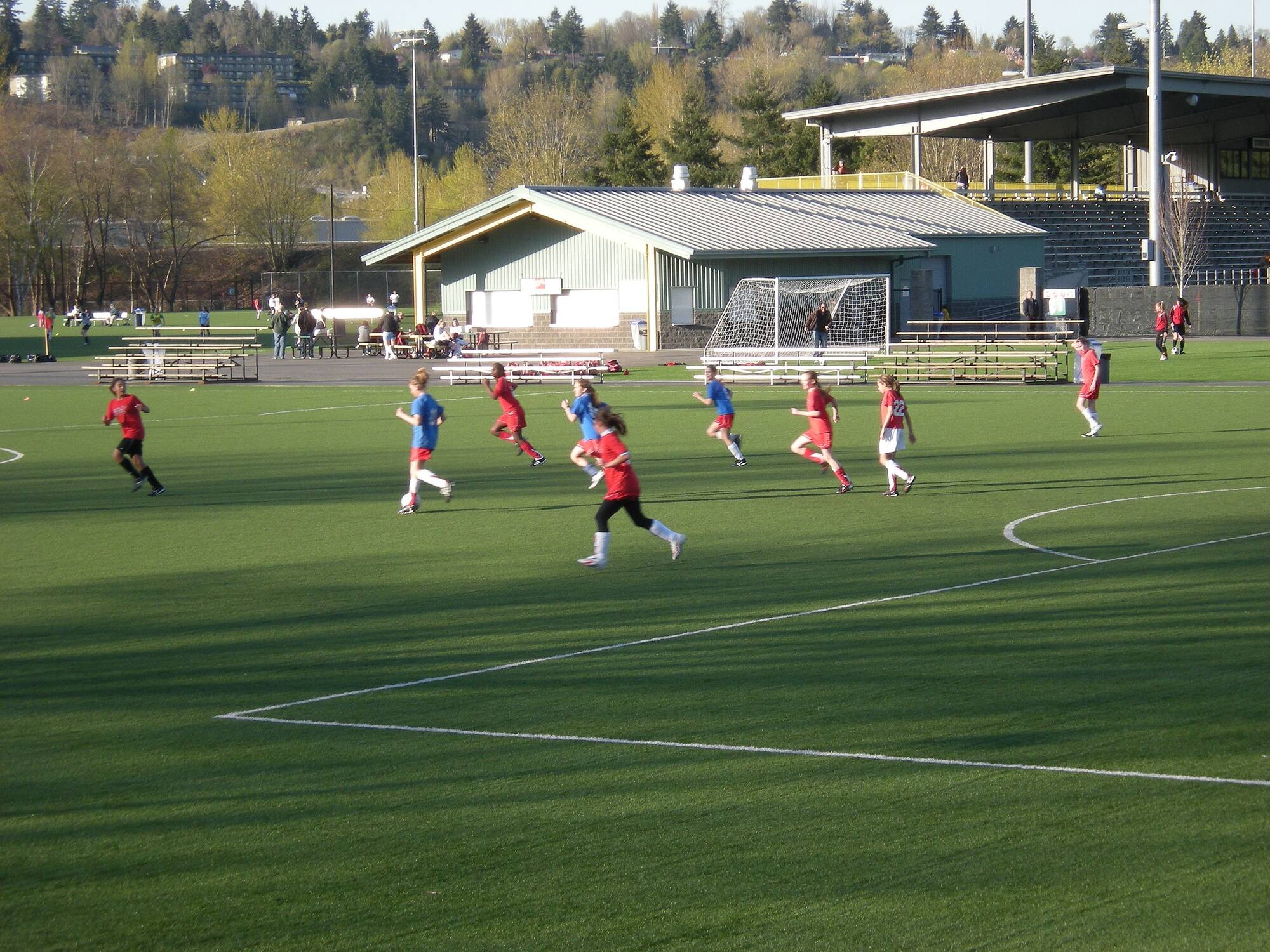
Middle school girls playing soccer on artificial turf. Soccer is a popular sport and is most commonly played on turf in upper divisions. Photo by Joe Mabel (Wikimedia Commons, Creative Commons Attribution-Share Alike 3.0 Unported license. Photo resized).
What is natural turf?
Natural turf is a defined area of grass that is cultivated and maintained and includes the parts above ground, the roots, and the soil. Various different grasses are used to create natural turf depending on the climate, soil conditions, and foot traffic patterns. Turf grasses are typically the same types of grasses used as lawn grasses. Common cool-season grasses—grasses that grow the most in the fall and spring and go dormant in the summer—include Kentucky bluegrass (Poa pratensis), tall fescue (Festuca arundinacea), and perennial ryegrass (Lolium perenne). Common warm-season grasses—grasses that grow the most during the summer and go dormant in cooler weather—include Bermuda grass (Cynodon dactylon), zoysia grass (Zoysia spp.), and bahia grass (Paspalum notatum).
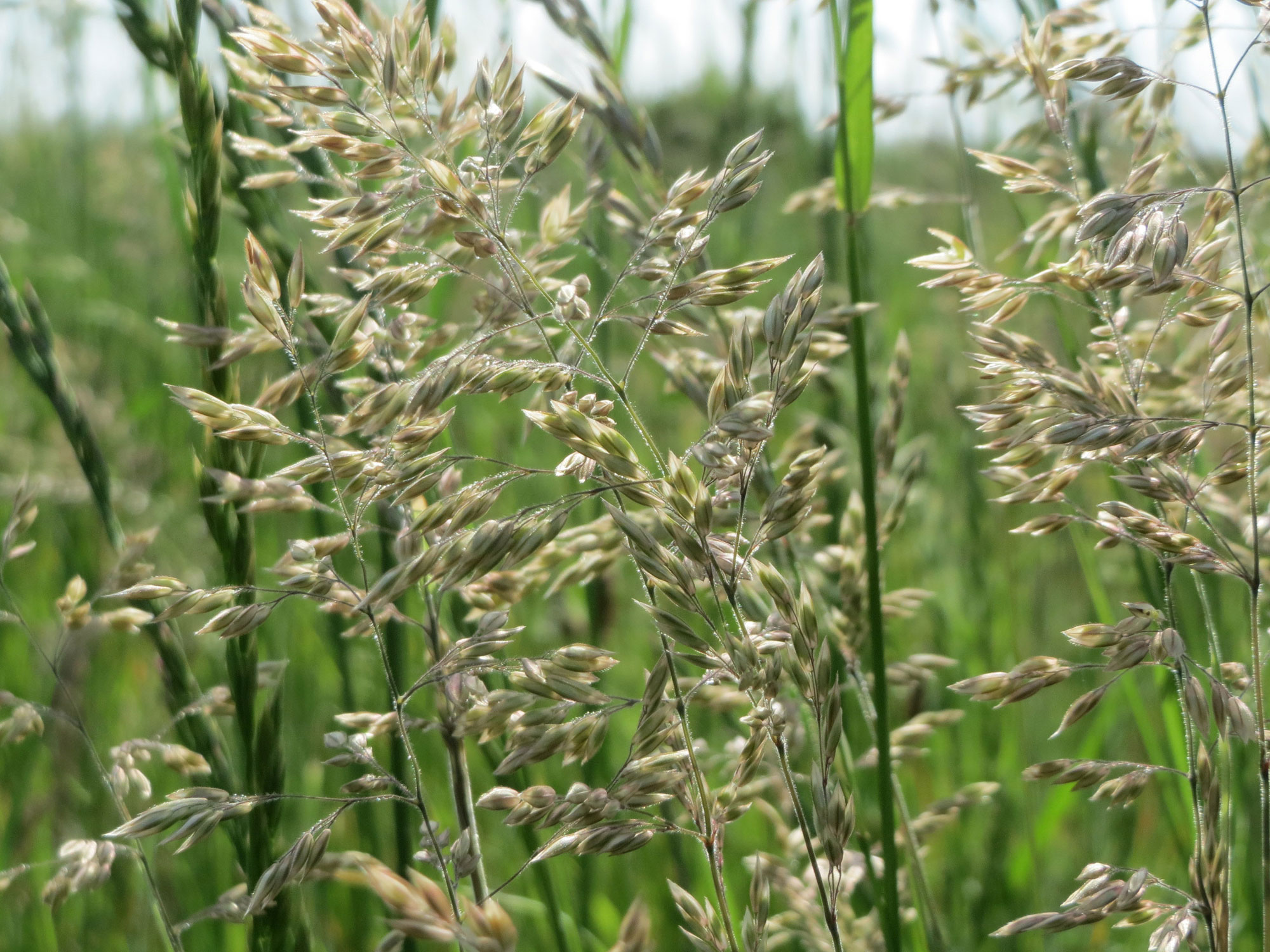
Kentucky bluegrass (Poa pratensis), Hockenheim, Germany. A commno cool season turf grass. Despite its common English name, Kentucky bluegrass is native to North Africa and Eurasia. Photo by AnRo0002 (Wikimedia Commons, Creative Commons CC0 1.0 Universal/public domain dedication).
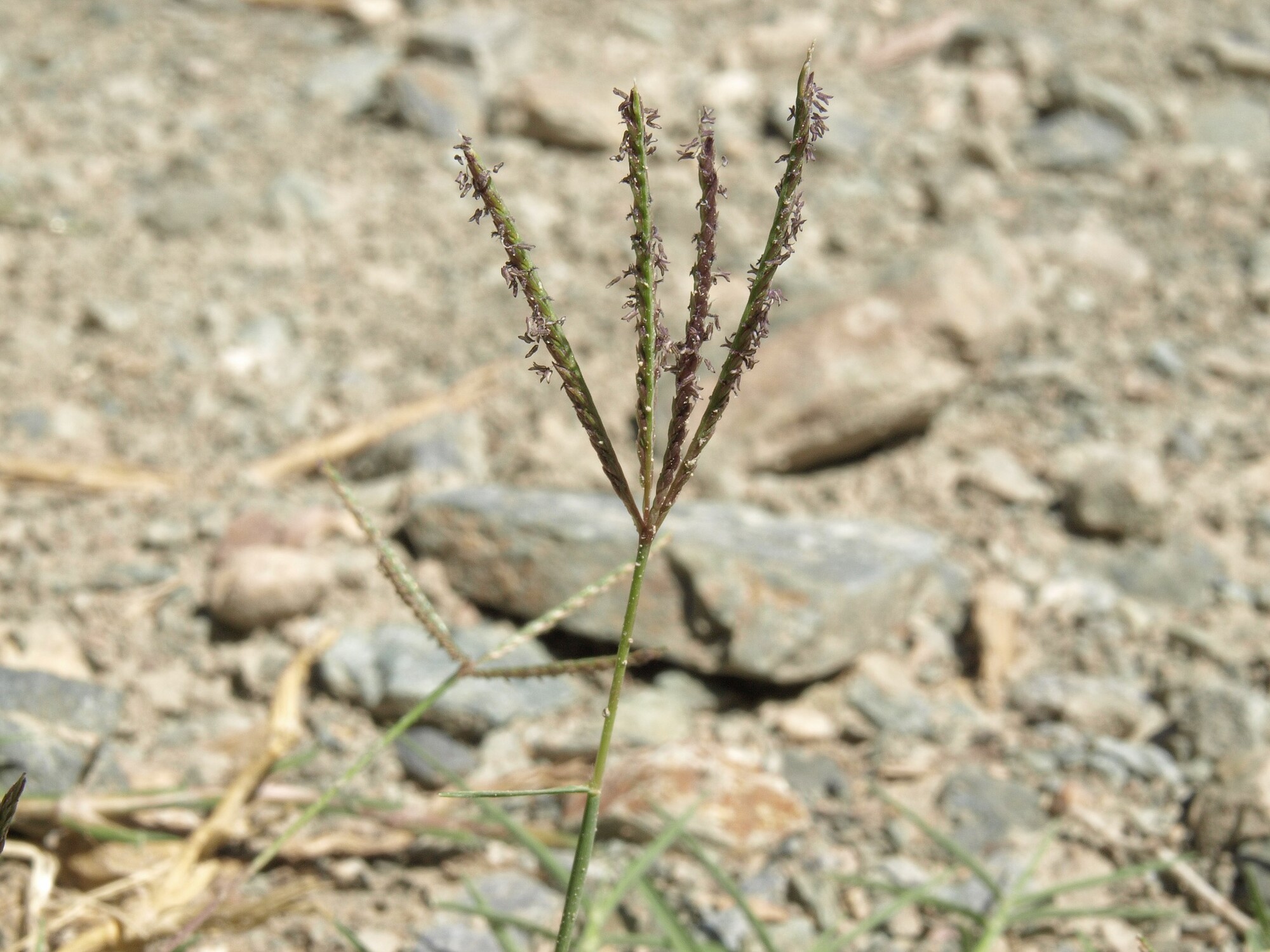
Bermuda grass (Cynodon dactylon), a common warm season turf grass. Photo by Jim Morefield (Wikimedia Commons, Creative Commons Attribution-Share Alike 2.0 Generic license, photo resized).
What is synthetic turf and what is it made out of?
Synthetic turf is a fake, nonliving, artificial grass that looks similar to real grass. Turf grass is made of polyethylene, polypropylene, a backing material such as latex or polyurethane, infill (loose material such as sand or rubber pellets that is added on top of the turf to help prop up the artificial grass blades and keep the turf smooth), and coating, which helps, for example, to keep the turf cooler on hot days and protect it from UV light.

A turf field outside of a high school. The lines are very vivid and distinct, unlike lines created on regular grass fields. Photo by TheRegentsInternationalSchoolBangkok (Wikimedia Commons, Creative CommonsAttribution-Share Alike 4.0 International license. Photo resized).
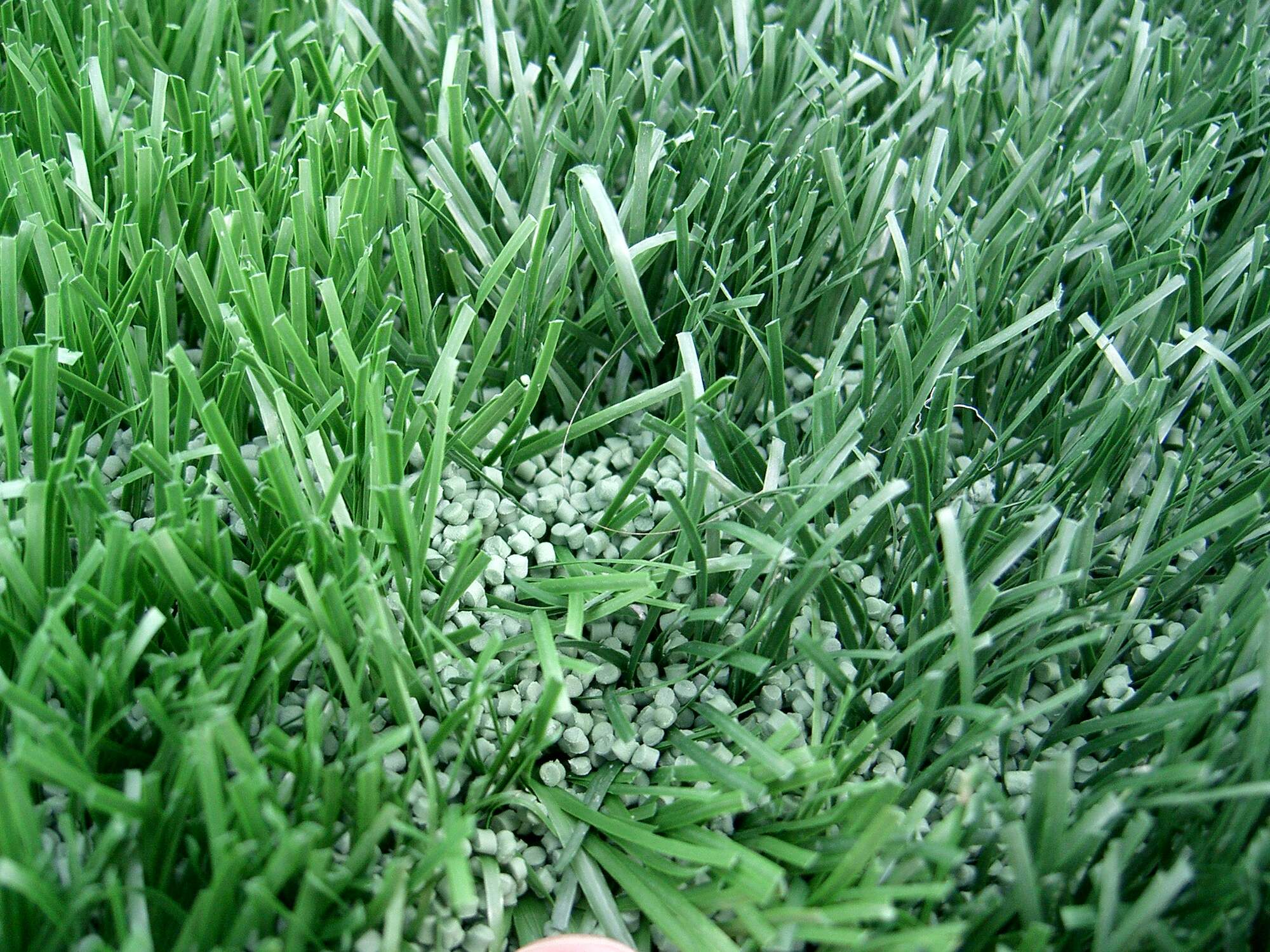
A close up of artificial turf, showing plastic grass blades and pellets of material used as infill. Photo by Drgutttorm (Wikimedia Commons, Creative CommonsAttribution-Share Alike 3.0 Unported license. Photo resized)
How common is synthetic turf?
Synthetic turf became widespread in the United States in the 1970s for baseball and football fields and was first referred to as AstroTurf. It was marketed as having benefits over natural turf that included faster game play. It was also said to be cheaper than grass turf (which is a misconception), since institutions would not have to pay to have someone mow the grass, chalk the lines, and perform other types of costly maintenance.
Since its introduction, artificial turf has gone through three generations of improvements and innovations. Today, artificial turf fields can be found everywhere from elementary schools to national sports leagues, and the use of artificial turf is experiencing continuous growth. The market for artificial turf is projected to reach $3.8 billion by 2025. Synthetic turf is now being used at stadiums as well as around private houses and in commercial gardens.
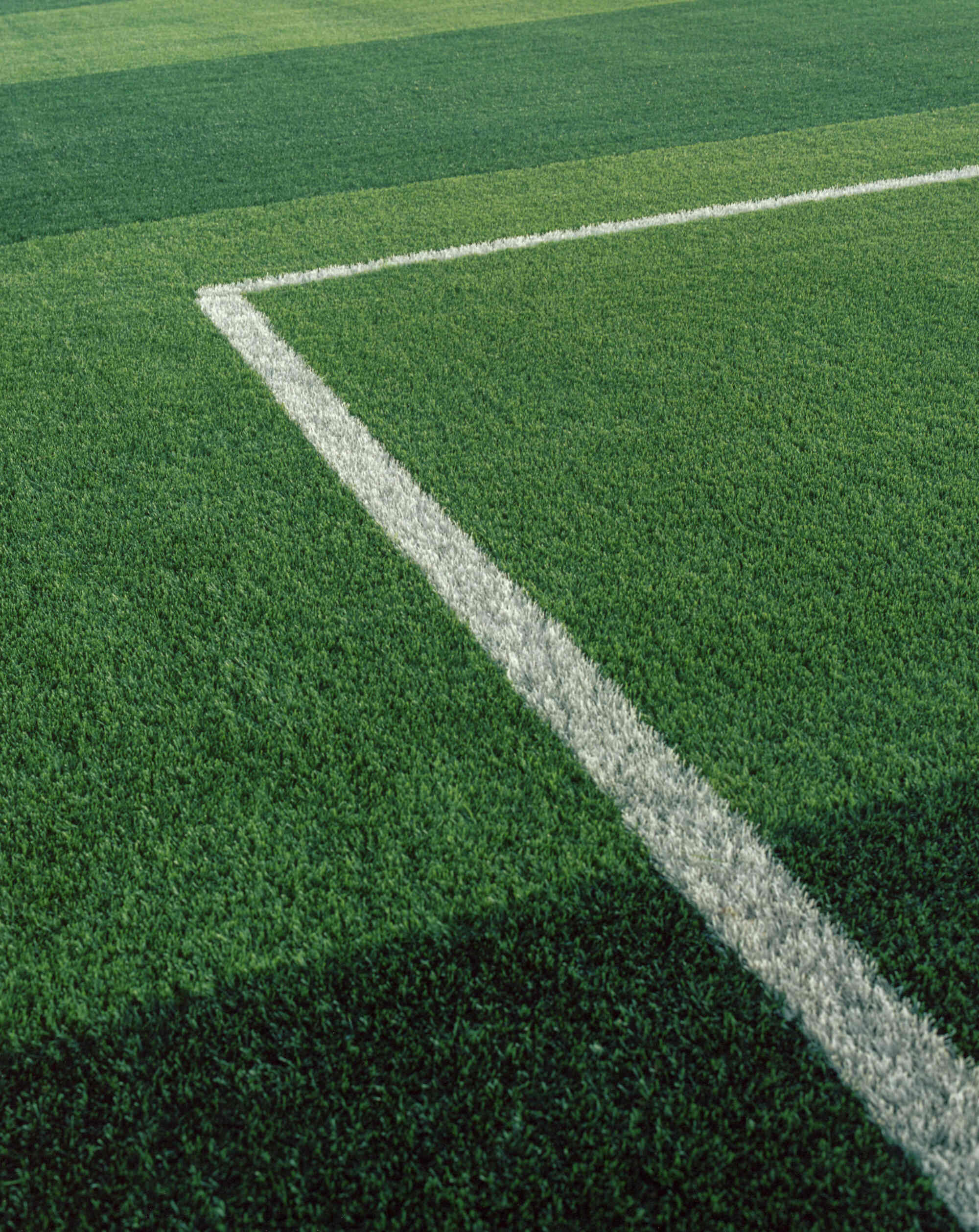
A close-up of synthetic turf. Plastic grass blades are short and look similar to real grass blades. The boundary line is very sharp and does not fade or get washed away by the rain, unlike lines chalked on natural grasss. Photo by Park taeho (Wikimedia Commons, Creative Commons Attribution-Share Alike 4.0 International license. Photo resized.)
Why is synthetic turf popular?
Many athletes like synthetic turf because it provides a consistent playing surface. The grass is uniform across all areas of the field. It contributes to faster and more exciting gameplay because the ball can glide farther instead of being slowed by holes and other inconsistencies that occur in natural grass turf.
Synthetic turf is considered to be more durable than natural turf in terms of both weather and withstanding heavy human foot traffic, as well as for sports that include sharp movements and pivoting, such as football and soccer. Synthetic turf is also marketed as a way for big institutions to save money, although when installation, equipment, and maintenance costs are considered, the monetary savings are likely relatively small.
Some synthetic turf is also used for residential yards. It may, for example, be an appealing option for people living in dry regions where growing green grass requires consistent watering. Some people may also install it to make functional or attractive outdoor spaces where grass cannot be grown (for example, over concrete or on a patio).
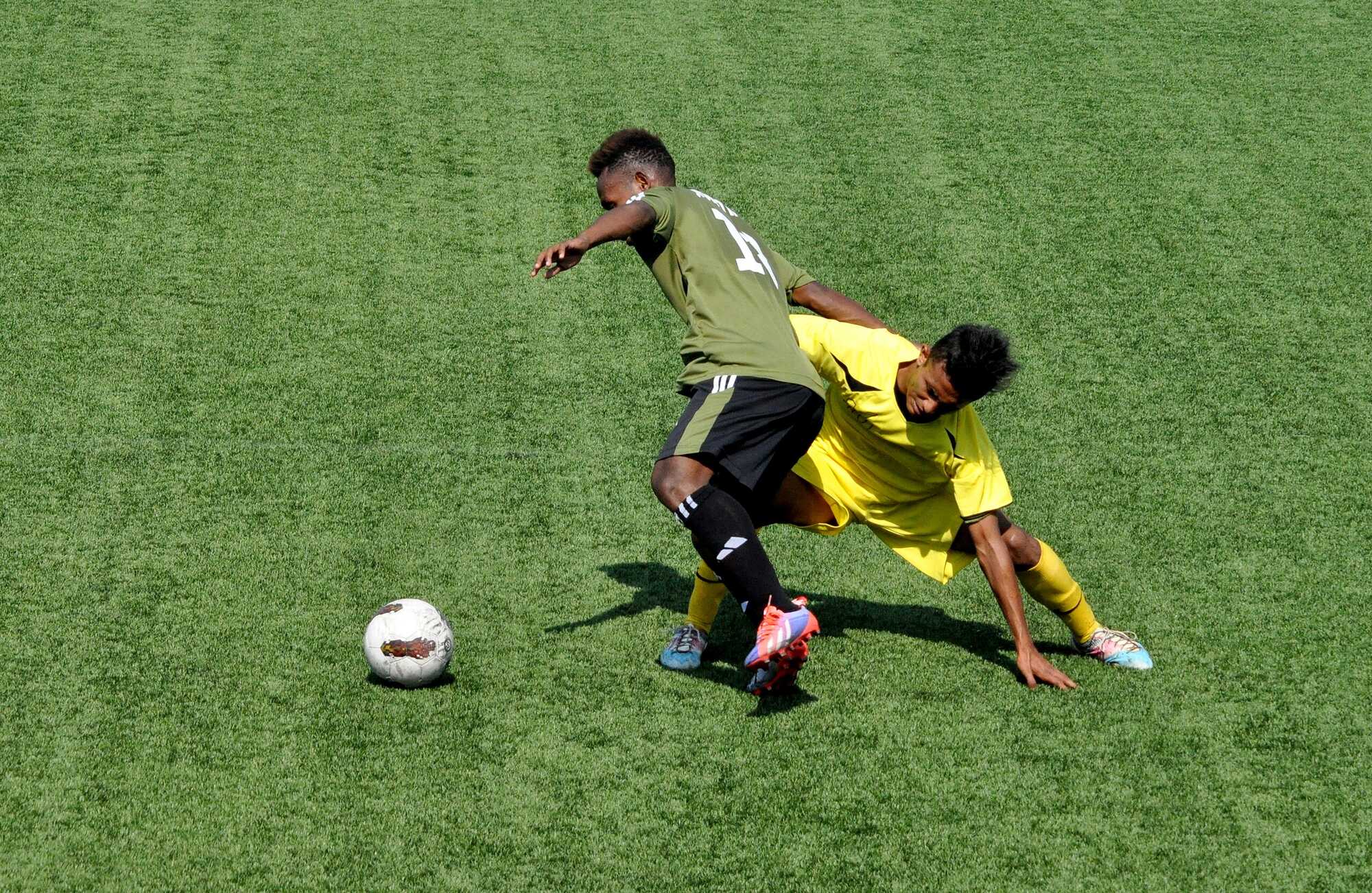
Two boys playing soccer on synthetic turf, Bahasa, Indonesia. Photo by Herasakha06 (Wikimedia Commons, Creative Commons, Creative Commons Attribution-Share Alike 4.0 International license. Photo resized)

A home in Sonoma, California, with an artificial turf lawn. Photo by Sarah Stierch (flickr, Creative Commons Attribution-Share Alike 2.0 Generic license, photo resized).
What is more cost effective, synthetic turf or natural turf?
There are many variables that may impact the expense of synthetic and natural grass turfs over their lifetimes, which makes generalized cost comparisons difficult. Overall, the costs of natural grass and synthetic turf may be similar when measured over time. Once purchased, synthetic turf needs to be replaced every eight to ten years (natural grass turf may also have to be replaced frequently, depending on how it is used). Synthetic turf has a significantly larger upfront price due to the combined costs of installation and materials; the cost may be up to several times that of natural grass.
The yearly maintenance costs of synthetic turf may be lower than or similar to those of natural grass, whereas the maintenance hours are often lower. Maintenance of synthetic turf includes grooming, disinfecting, weeding, brushing debris, infill replacement, mending seams or tears, and eliminating pests underneath the turf. Maintenance for natural grass turf includes regular mowing, fixing patches or holes, watering, fertilizing, application of chemical (herbicides, pesticides), and, for athletic fields, chalking boundary lines.
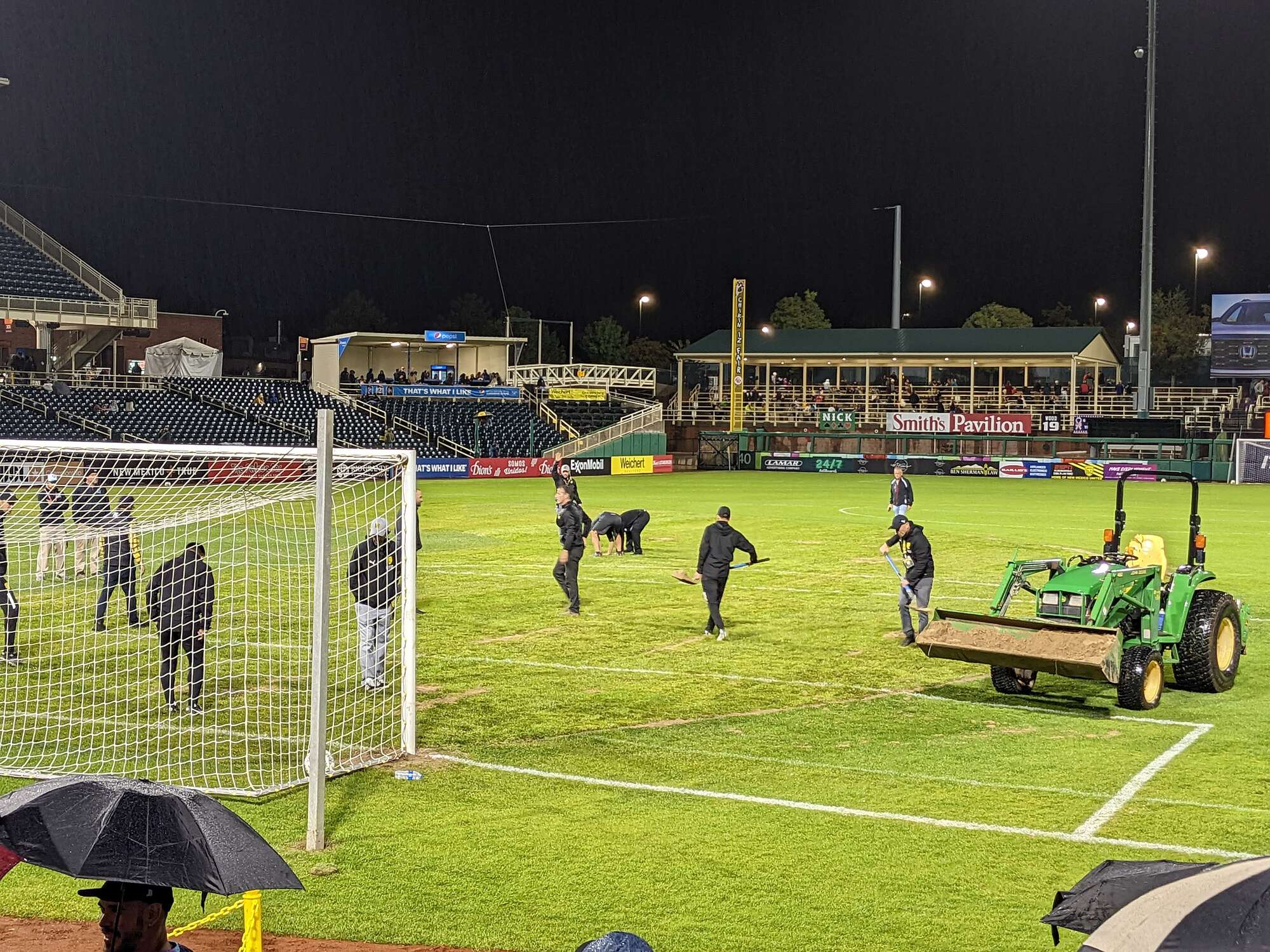
A grounds crew working to repair a natural grass athletic field after a storm. The mud and sod can be slippery and dangerous during poor weather conditions. Photo by Matthew Kowal (Wikimedia Commons, Creative Commons Attribution-Share Alike 4.0 International license. Photo resized.)
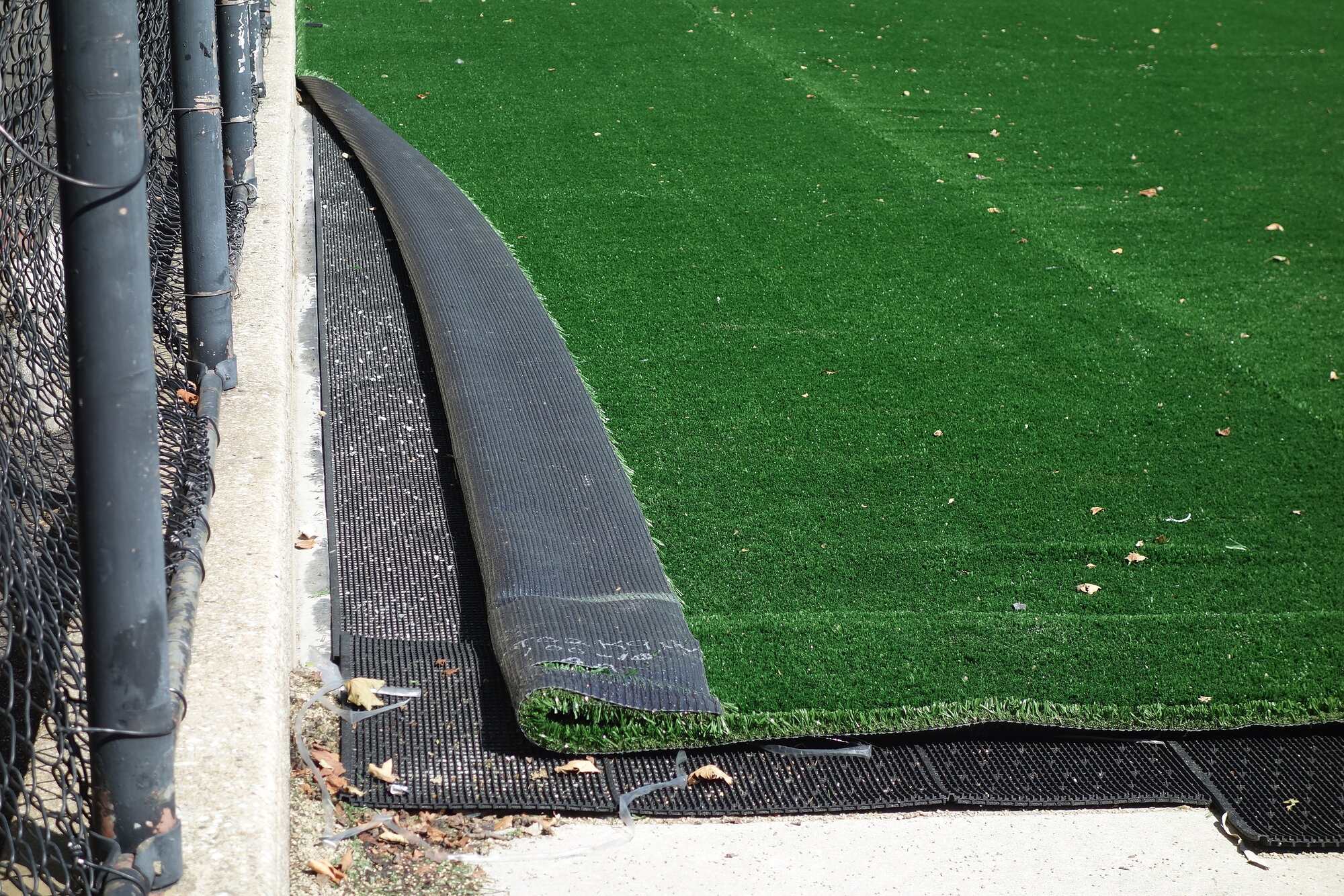
Layers of turf pealing back. Artifical turf needs to be replaced periodically. Photo by Tdorante10 (Wikimedia Commons, Creative Commons Attribution-Share Alike 4.0 International license. Photo resized).
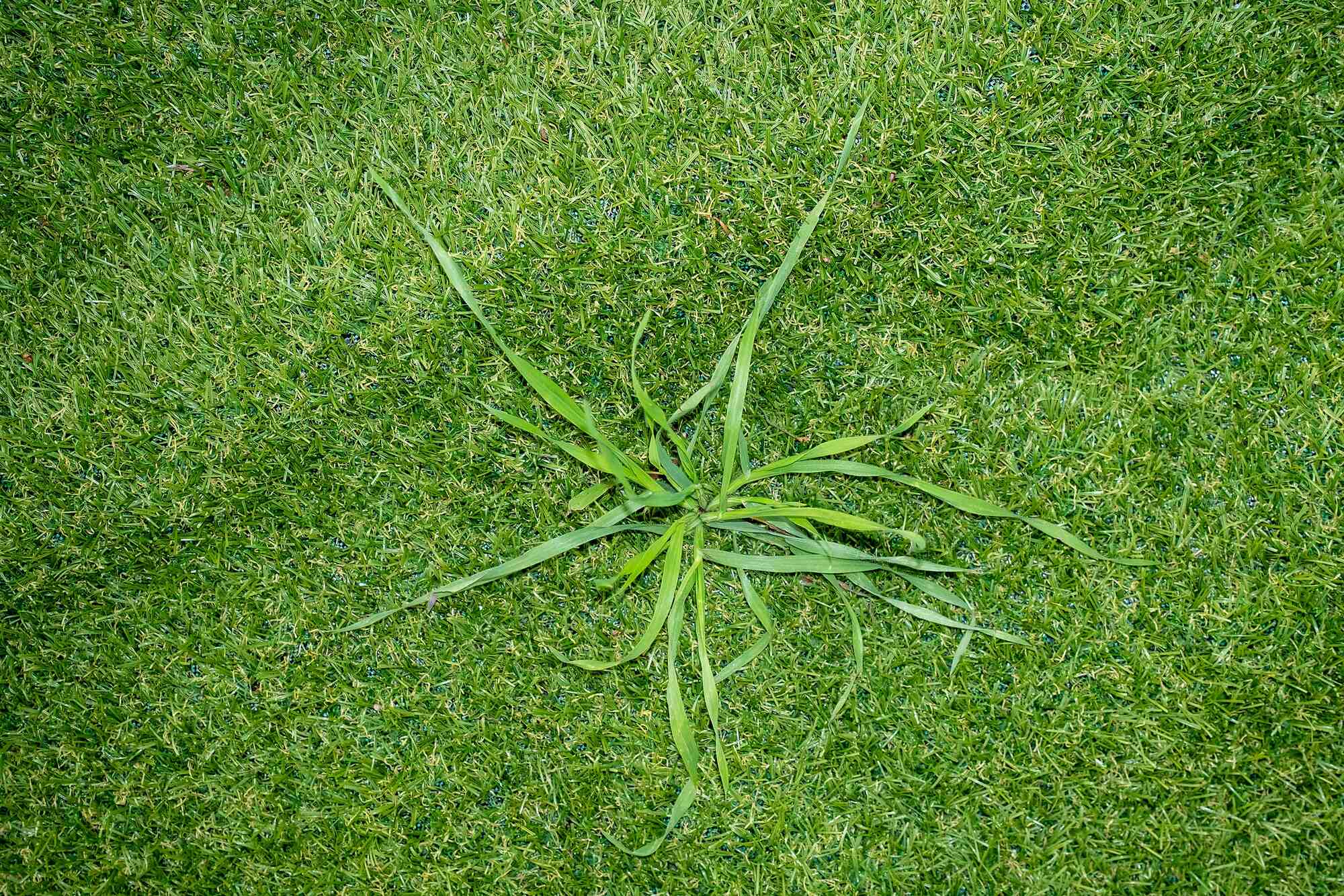
Grass growing through artificial turf. Photo by Tdorante10 (Wikimedia Commons, Creative Commons Attribution-Share Alike 4.0 International license. Photo resized).
What are the main benefits and drawbacks of synthetic turf?
Potential benefits of synthetic turf:
The benefits of synthetic turf primarily come from eliminating some of the major drawbacks associated with maintaining natural grass turf. Synthetic turf:
- May save water.
- Eliminates the use of pesticides, herbicides, and fertilizers.
- Reduces the use of and emissions from fossil fuels burned by gas-powered lawn maintenance equipment.
- May require lower maintenance than natural grass as measured by hours worked per year.
- May provide better gameplay than natural turf when used on athletic fields.
- Can be used continuously, even in high-impact or high-traffic situations.
- May be an attractive and functional alternative in areas where growing grass is not a realistic option.
Potential drawbacks of synthetic turf:
The drawbacks of synthetic turf are varied and are associated with its manufacture, disposal, environmental impacts, and properties as an athletic field surface compared to natural grass. Synthetic turf:
- May destroy habitat when it replaces natural grass or other landscaping that uses live plants, particularly for insects and burrowing animals.
- Has a large carbon footprint due to manufacturing, transportation, and installation.
- Must be replaced periodically and is most commonly discarded in landfills.
- Contributes to runoff because it has no roots to absorb the water during rainfall.
- Can form microplastics that contaminate the soil and water.
- Contains PFAS (long-lived chemicals), which could have harmful health impacts.
- Can reach high temperatures under certain conditions.
- May increase the risk of athlete injury when used on athletic fields.
- Can be costly to install and replace.
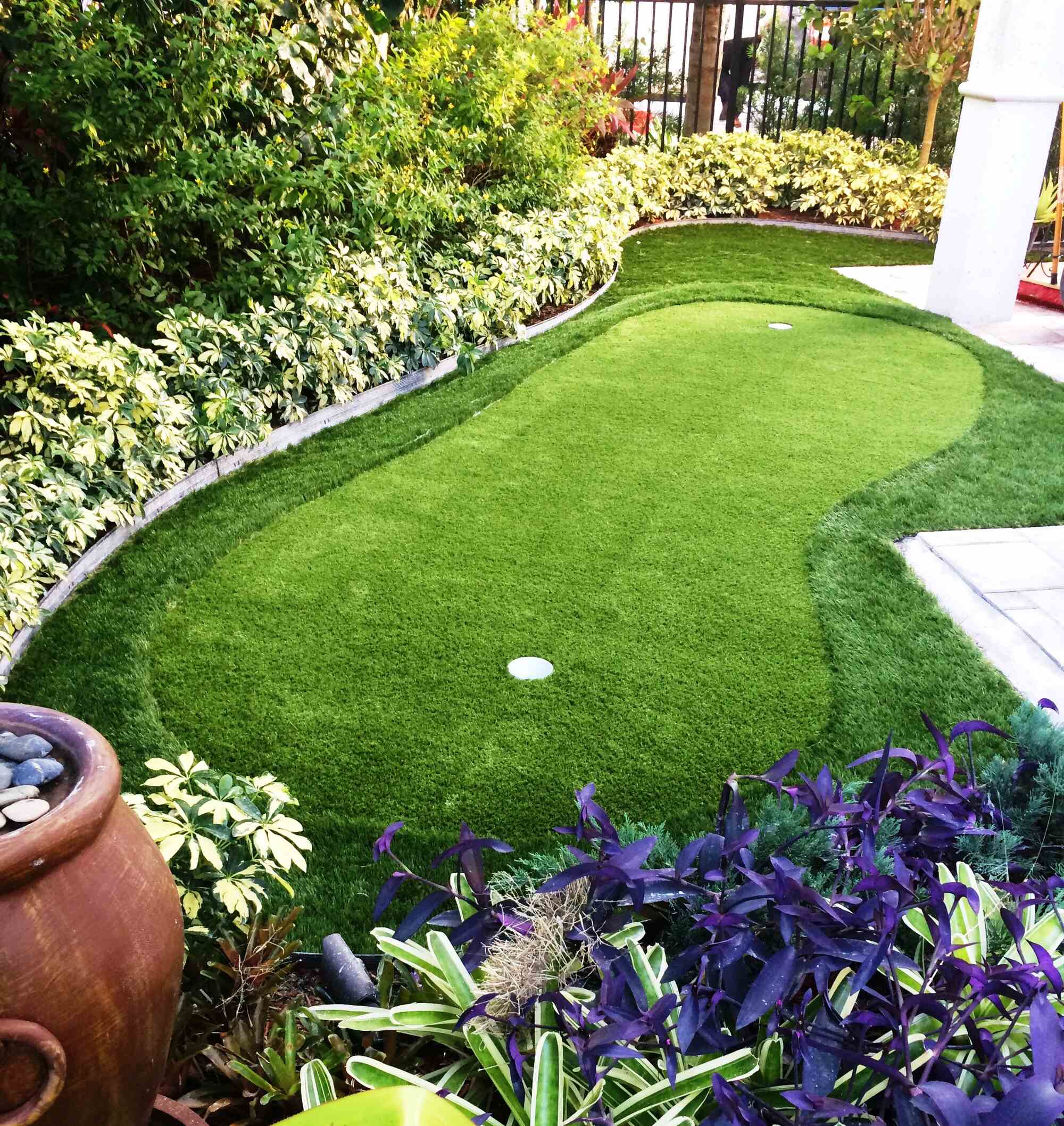
A putting green made using artificial turf. Photo by ProGreenGrass (Wikimedia Commons, Creative Commons Attribution-Share Alike 4.0 International license. Photo resized).
Resources
Websites
Per- and polyfluoroaklyl substances (PFAS) (U.S. Environmental Protection Agency): https://www.epa.gov/pfas
Articles & reports
Claudio, L. 2008. Synthetic turf: Health debate takes root. Environmental Health Perspectives 116: A116-A122. https://doi.org/10.1289/ehp.116-a116
Grand View Research. Artificial turf market size, share & trends report by material (polyethylene, polypropylene, nylon), by application (residential, commercial, sports), by region, and segment forecasts, 2019-2025. GVR-3-68038-667-7 (120 pp.). https://www.grandviewresearch.com/industry-analysis/artificial-turf-market#
Perkins, T. 2022. Boston bans artificial turf in parks due to toxic 'forever chemicals.' The Guardian, 30 September 2022. https://www.theguardian.com/environment/2022/sep/30/boston-bans-artificial-turf-toxic-forever-chemicals-pfas
Sawyers, H. and G. Han. 2021. Why we don't recommend artificial grass for most people. Wirecutter (The New York Times), 9 July 2021. https://www.nytimes.com/wirecutter/reviews/best-artificial-grass/
Scientific articles
Daviscourt, B. L., A. R. Kowalewski, J. G. Lambrinos, and B. Eleveld. 2017. A life-cycle cost analysis of synthetic infill and natural grass systems. International Turfgrass Society Research Journal 13: 373-379. https://doi.org/10.2134/itsrj2016.10.0848
Murphy, M., and G. R. Warner. 2022. Health impacts of artificial turf: Toxicity studies, challenges, and future directions. Environmental Pollution 310: 119841. https://doi.org/10.1016/j.envpol.2022.119841



